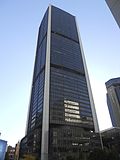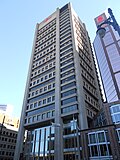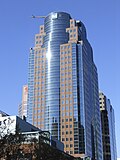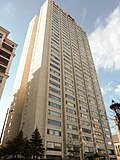Top Qs
Timeline
Chat
Perspective
List of tallest buildings in Montreal
From Wikipedia, the free encyclopedia
Remove ads
Montreal's skyline is the largest in Quebec and one of the largest in Canada, with 71 buildings in the city that reach a height greater than 100 metres (330 ft), 16 of which are taller than 150 metres (490 ft) as of 2025[update]. Montreal has the largest skyline and the tallest buildings in Canada east of Toronto, the only city in Canada with a greater population. Since 1992, municipal regulations have limited the height of any new buildings from exceeding the height of Mount Royal, which rises 232.5 m (763 ft) above mean sea level.[1]

The history of skyscrapers in Montreal began with the completion of the eight-storey New York Life Insurance Building in 1888.[2] Following an early modest boom from the late 1920s to the early 1930s, Montreal's skyline was left unchanged until the early 1960s, when the construction of high-rises picked up again. This second, larger boom, which lasted until the early 1990s, was dominated by commercial office towers, such as Tour de la Bourse, which was the tallest building in Canada from 1964 to 1969. While not a habitable building, the Montreal Tower is a notable landmark in the city. Part of the city's Olympic Stadium, it was planned to be built in time for the city's 1976 Summer Olympics, but ultimately opened in 1987. It is the tallest inclined structure in the world at 165 m (541 ft). Montreal's tallest building, 1250 René-Lévesque, and its second tallest, 1000 de La Gauchetière, were both built in 1992, marking the end of the boom.
A third building boom would begin in the 2010s, with residential and mixed-use buildings making up an increasing share of new development. The downtown skyline expanded significantly, especially towards the southwest, around the Bell Centre. Notable additions include the three-tower Tour des Canadiens complex, built between 2013 and 2021, as well as Roccabella (2016) and L'Avenue (2020). The mid-2020s saw the completion of five new skyscrapers that approach the city's height limit of around 200 m: Victoria sur le Parc (2024), Banque Nationale Headquarters (2024), Maestria (2025), 1 Square Phillips (2025), and the currently under construction 900 Saint-Jacques, reflecting a growing demand for vertical space.
Most of Montreal's tallest buildings are located in Downtown Montreal, forming the core of a continuous area of high-rises extending towards Shaughnessy Village to the southwest of downtown and Griffintown to the southeast. Both areas have seen increased high-rise development beginning in the 2010s. In addition, high-rises can be found along the coast of Nun's Island south of downtown, and recent developments on the island in the 2020s, such as Evolo X and Symphonia VIU, have exceeded a height of 100 m (330 ft). The Belvédère Kondiaronk lookout on Mount Royal is a popular viewpoint for the city's skyline.
Remove ads
History
Summarize
Perspective
1900s–1950s

In the first half of the 20th century, Montreal was the largest city in Canada, as well as its economic centre. As a result, the city is home to many of Canada's earliest high-rises, featuring a variety of architectural styles. Montreal had many of Canada's tallest buildings, which only Toronto rivalled in height.The first high-rise in Montreal is considered to be New York Life Insurance Building in Old Montreal, the tallest commercial building in the city at the time of completion in 1889. Constructed in the Richardsonian Romanesque style for the New York Life Insurance Company, the building's Old Red Sandstone was imported from Dumfriesshire, Scotland.[3] However, the city's tallest building overall was the Notre-Dame Basilica, a minor basilica built in 1865. Another early high-rise, also in Old Montreal, was the Renaissance Revival Canada Life Building, built in 1895.
A construction boom towards the mid-to-late 1920s, during the Roaring Twenties. The neoclassical Royal Bank Tower, upon completion in 1928, became the first building in the city to surpass the Notre-Dame Basilica with a height of 121 m (397 ft); it was the tallest building in Canada and all of the British Empire.[4] The Art Deco Aldred Building, 96 m (315 ft) tall, was completed in 1930, with setbacks that allowed light onto the Place d'Armes square and evoked the cathedral-like massing of the adjacent Notre-Dame Basilica. The Bell Telephone Building, also 96 m tall, was completed in 1929, and contained the head offices of the Bell Telephone Company. The Royal Bank Tower would soon be ever so slightly eclipsed by the 122 m (400 ft) Sun Life Building in 1931. The 7-storey base of the skyscraper had been built by 1918, with the tower being added later.
After the end of the boom, brought about by the Great Depression, few high-rises would be added to the city for over two decades leaving the skyline largely unchanged until the early 1960s. One possible exception is the tower on the main campus of the Université de Montréal. Construction on the campus and the tower, to the west of Mount Royal, began in 1924 and was only completed in 1943.[5] The 22-storey tower was designed with both Beaux Arts and Art Deco influences.[6]
1960s–1990s

A large building boom began in the early 1960s, whereupon many commercial skyscrapers were built in the city. The centre of commercial activity shifted from the historic Old Montreal to the core of today's Downtown Montreal. The first building to surpass the height of the Sun Life Building was CIBC Tower, a 187 m (614 ft) office tower that housed the Canadian Imperial Bank of Commerce. It would only hold the title of Montreal's tallest building very briefly, for it was soon overtaken by the cross-shaped Place Ville Marie in the same year. About three storeys of height was added to Place Ville Marie to ensure it would be taller than CIBC Tower. During the 1960s, Montreal had some of the tallest skyscrapers outside the United States, with the Place Ville Marie being the third tallest upon completion. Only two years after Place Ville Marie was built, Tour de la Bourse became the city's tallest building in 1964; it was also the tallest reinforced concrete building in the world until the completion of Lake Point Tower in Chicago. Like similar waves of construction in other Canadian cities such as Toronto or Vancouver, Montreal adapted the International style for most of its new towers during this period.

There were a few exceptions to the trend of office buildings, such as Château Champlain, a hotel skyscraper built in 1966 to accommodate visitors to Expo 67, the city's upcoming world's fair. It is notable for its distinctive arch-shaped windows. The Le Port-Royal Apartments at Golden Square Mile, on the western edge of downtown, was one of the city's earliest residential high-rises, completed in 1964 in the modernist style. While short compared to other high-rises built during the 1960s, the Habitat 67 housing complex, built in Cité du Havre for Expo 67, is recognized as a unique architectural landmark. Designed by Israeli-Canadian-American architect Moshe Safdie as his thesis project at McGill University, Habitat 67 was designed to integrate the benefits of suburban living within the density and economics of an apartment building. Its interlocking forms and landscape terraces have made it one of Montreal's most unique high-rises.
Montreal was selected as the host for the 1976 Summer Olympics in 1970, and work began in 1973 for the city's Olympic Stadium north of downtown. The stadium was to incorporate a 165 m (541 ft) tower, named Montreal Tower, that would be the tallest inclined structure in the world. However, the project was plagued by multiple issues, such as Montreal's brutal winters, and the tower would not be finished until 1987, 11 years after the games.[7][8] The tower features an observatory, accessed via an inclined elevator, that offers visitors views of the Montreal skyline. Also built for the Olympics was the city's Olympic Village to house the games' athletes, consisting of two pyramid-shaped 23-storey high-rises.[9] Similar to Montreal Tower, the Olympic Village suffered cost overruns.
The city's commercial building boom continued in the 1970s; notable developments include the four-building Complexe Desjardins (1975), which has a mall at its base, and Complexe Maisonneuve (1983). Later office towers from the mid-1980s adopted postmodernist architecture, such as KPMG Tower (1987), the Bell Media Tower (1988), and 1501 McGill College (1992). The boom would come to an end in 1992, with the completion of Montreal's two tallest buildings: 1250 René-Lévesque and 1000 de La Gauchetière. When measured by architectural height, 1250 René-Lévesque is the taller of the two due to its spire, which brings it to a height of 226.5 m (743 ft). If measured by roof height, 1000 de La Gauchetière is the city's tallest building at 205 m (673 ft).
By this point, Toronto had overtaken Montreal in urban population as well as economic importance, which was reflected in the heights of its tallest buildings. In 1992, Montreal adopted its first ever urban plan, prohibiting any building in the city from exceeding the altitude of Mount Royal. This equates to a height restriction of 232.5 m above mean sea level, effectively a height limit of about 200 m (656 ft) in Downtown Montreal,[10][1] ensuring that 1000 de La Gauchetière and 1250 René-Lévesque would retain their positions as Montreal's two tallest buildings indefinitely.
2000s–present

High-rise development slowed down significantly in the 1990s, until the start of another construction boom in the late 2000s. The only building taller than 100 m (328) to appear between this period was the taller of the two-tower E-Commerce Place complex (Cité du commerce électronique, or CCE in French). Completed in 2003, it was part of a program from the Quebecois government to promote jobs in information technology, with the creation of the Cité du Multimédia neighbourhood. Construction of new high-rises had returned earnestly by the 2010s, with many residential and mixed-use buildings being built downtown, such as Altitude Montreal (2013), Tour Air Canada (2014), and Tom Condos (2018), densifying the existing skyline.
In particular, a lot of new construction has occurred around the Bell Centre, expanding the core of the skyline southwest. This included the three-tower Tour des Canadiens complex, built between 2013 and 2021, and named after the Montreal Canadiens hockey team based at the Bell Centre; L'Avenue, a mixed-use skyscraper completed in 2020; and Deloitte Tower, the tallest office tower built in the city in the 2010s. Deloitte Tower was the city's first privately owned and financed commercial office tower to be built in more than 20 years.[11] The building boom approached the maximum height allowed under the city's height restrictions by the 2020s, with four new skyscrapers reaching this limit. This includes the residential towers of Victoria sur le Parc, Maestria, and 1 Square Phillips, as well as the tallest office building built after the 1990s, Banque Nationale Headquarters. The skyscraper became the new headquarters of the National Bank of Canada upon completion. All four skyscrapers were completed between 2024 and 2025; a fifth, Skyla, is topped out and expected to be complete in 2025.
The area of Shaughnessy Village further southwest has seen a recent increase in height with the two-tower 27-storey Alexander Appartements and EstWest Condos, and especially 1111 Atwater, the first building in the area to pass 100 m (328 ft). All of those developments were completed between 2021 and 2022. The neighbourhood of Griffintown, formerly industrial land, has been undergoing redevelopment since the 2010s, transforming it into a livable, residential high-rise neighbourhood.[12][13] To the north of downtown, the Centre hospitalier de l'Université de Montréal (CHUM) completed a new hospital complex in 2021.[14][15] Measuring 112 m (368 ft) tall, it is Montreal's tallest health building, and the only one to exceed 100 m (328 ft).
Residential high-rises have been built on Nun's Island since the 1980s, but the 2010s saw a noted increase in the height of new buildings on the island, especially on the northern tip and the southern tip of the island, which is reclaimed land. The towers on the northern tip form the Évolo development; the tallest building, Évolo X, was built in 2020 at a height of 120 m (394 ft). Likewise, the high-rises on the southern tip all begin with "Symphonia"; the tallest, Symphonia VIU, became the tallest building in the city outside of downtown upon completion in 2024. Altogether, there are three buildings on Nun's Island that surpass 100 m (328 ft). A fourth, Symphonia MUZ, is planned.
During Montreal's mayoral election in 2021, former mayor Denis Coderre had suggested to abolish Montreal's height limit regarding Mount Royal in order to combat urban sprawl and increase the supply of new housing.[16] This prompted a debate on the benefits and costs of removing the height limit;[17] ultimately, Coderre was not elected, and the restriction remains today.
Remove ads
Cityscape

Tallest buildings
Summarize
Perspective
This list ranks buildings in Montreal that stand at least 100 m (328 ft) tall as of 2025, based on CTBUH height measurement standards. This includes spires and architectural details but does not include antenna masts. Freestanding observation and/or telecommunication towers, while not habitable buildings, are included for comparison purposes; they are not ranked. One such tower is the Tour de Montréal.
Was the tallest building in Montreal upon completion
Remove ads
Tallest under construction or proposed
Summarize
Perspective
Under construction
The following table ranks high-rises that are under construction in Montreal that are expected to be at least 100 m (328 ft) tall as of 2025, based on standard height measurement. The “Year” column indicates the expected year of completion. Buildings that are on hold are not included. A dash "–" indicates information is unknown or not publicly available. No new skyscrapers in Montreal can exceed the height limit of 200 m (656 ft) as per municipal regulations.[131][132][133]
Proposed
The following table ranks proposed and approved high-rises in Montreal that are expected to be at least 100 m (328 ft) tall as of 2025, based on standard height measurement. The “Year” column indicates the expected year of completion. A dash "–" indicates information is unknown or not publicly available.
Remove ads
Timeline of tallest buildings
This lists buildings that once held the title of tallest building in Montreal.
Remove ads
Map of tallest buildings
Summarize
Perspective
The following map shows the location of buildings in Downtown Montreal that are taller than 100 m (328 ft). Each marker is coloured by the decade of the building's completion. There are six buildings, outside of a total of 71, that are located outside the scope of the map and hence are not visible. These are: 1111 Atwater in Shaughnessy Village; CHUM and Le Maison de Radio-Canada to the north of downtown; and Evolo X, Symphonia POP, and Symphonia VUE on Nun's Island.

200m
218yds
218yds
71
70
69
68
67
66
65
64
63
62
61
60
59
58
57
56
55
54
53
52
51
50
49
48
47
46
45
44
43
42
41
40
39
38
37
36
35
34
33
32
31
30
29
28
27
26
25
24
23
22
21
20
19
18
17
16
15
14
13
12
11
10
9
8
7
6
5
4
3
2
1
Buildings taller than 100 m (328 ft) in Montreal. An asterisk (*) next to the name of the building indicates it is located outside the map.
- 1950s and before
- 1960s
- 1970s
- 1980s
- 1990s
- 2000s
- 2010s
- 2020s
1
1250 René-Lévesque2
1000 de La Gauchetière3
Victoria sur le Parc4
Maestria Tour B5
Banque Nationale Headquarters6
1 Square Phillips7
Tour de la Bourse8
Place Ville-Marie9
CIBC Tower10
L'Avenue11
Maestria Tour A12
Tour des Canadiens 313
Tour des Canadiens 214
Tour des Canadiens15
1501 McGill College16
Complexe Desjardins South Tower17
Le George18
Solstice Montréal19
Roccabella (East Tower)20
Roccabella (West Tower)21
Icône22
KPMG Tower23
Symphonia VIU*24
Marriott Château Champlain25
Le V / Courtyard Marriott Hotel26
Telus Tower27
500 Place D'Armes28
Deloitte Tower29
Complexe Desjardins East Tower30
Scotia Tower31
National Bank Tower32
700 de la Gauchetière33
1000 Sherbrooke West34
Terminal Tower35
Bell Media Tower36
Altitude Montreal37
Sun Life Building38
Le Port-Royal39
Tom Condos40
Tour de la Banque Royale41
Holiday Inn Montréal Centre-Ville West42
Humaniti Montréal43
YUL Tower 144
Maison Manuvie45
628 Saint-Jacques46
Evolo X*47
YUL Tower 248
1111 Atwater*49
Tour Air Canada50
Appartements Dorchester II51
Livmore Ville-Marie Phase 152
IVY Montréal + Hôtel Honeyrose53
Quinzecent54
E-Commerce Place55
Le Centre Sheraton56
Le Peterson57
Place du Canada58
AC Hotel / Allegra Montreal59
400 Sherbrooke West60
CHUM*61
Edifice Hydro Quebec62
500 Boulevard René-Lévesque Ouest63
Complexe Desjardins, North Tower64
Evo Montreál65
Symphonia POP*66
Tour Intact67
Hotel Omni Montreal68
Place Sherbrooke69
1100 René-Levesque Boulevard70
Le Maison de Radio-Canada*71
Le CrystalRemove ads
See also
References
Wikiwand - on
Seamless Wikipedia browsing. On steroids.
Remove ads




































































